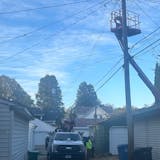Two years of the pandemic have been particularly long for Dr. Richard Palahniuk, Minnesota's first known case of COVID-19.
Since testing positive on March 6, 2020, the retired anesthesiologist has feared the return of the worst illness of his life. He'll never forget days of shivering in a parka while huddled by a fire. Or nights of burning up in sweat-soaked sheets. Or struggling with exhaustion for days or losing his sense of taste and smell for three months.
Only recently has the 77-year-old stepped out with his wife for an early dinner or matinee.
"We're sitting a mile from the nearest other person," he said.
Palahniuk's caution exemplifies Minnesota after two years of COVID-19. State leaders hope after five waves and 1.4 million confirmed infections, the pandemic is transitioning into a predictable and manageable endemic.
But they haven't forgotten the premature celebrations last summer, when hopes were dashed by a fast-spreading delta coronavirus variant that prolonged the pandemic. Another 4,300 COVID-19 deaths have occurred in Minnesota since July, pushing the toll past 12,000.
"It was heartbreaking ... the gut punch of thinking things were stabilizing or getting better and then the next thing comes along," state Health Commissioner Jan Malcolm said.
Minnesota now may be in for a break since the five-month-long delta wave gave way to an omicron variant that produced record infections this winter. An estimated 70% of Minnesotans have temporary immunity against omicron because of vaccination or infection, according to the Institute for Health Metrics and Evaluation (IHME) in Washington state.


